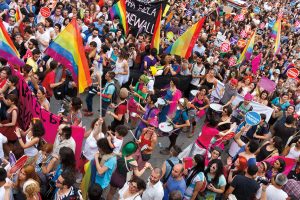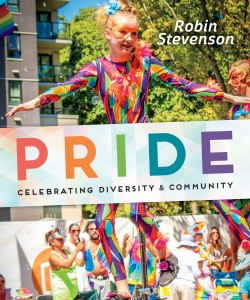
For the last day of Pride Month, we have a language lesson adapted from Pride: Celebrating Diversity & Community by Robin Stevenson.
Last week’s interview with a transgender youth revealed how words and names are tied to identity, and, as Robin tells us in her book, inclusive language is important to the LGBTQ community. Inclusive language is a powerful way for teachers and parents to ensure that young people feel accepted and supported.
Finding the right word can be a challenge, so here are some useful definitions from Robin’s book.
Let’s look first at the acronyms:
LGBT or LGBTQ: Lesbian, Gay, Bisexual, Transgender, Queer (or Questioning)
QUILTBAG: Queer/Questioning, Undecided, Intersex, Lesbian, Trans (Transgender/Transsexual), Bisexual, Asexual (and Ally), Gay/Genderqueer.
GSM: Gender and Sexual Minorities.
2S: Two-Spirit or Two-Spirited
Now let’s look at the individual terms (in order of their appearance above):
Lesbians: women who are primarily attracted to other women.
Gay: people who are attracted primarily to members of the same sex.
Bisexuals: people who are attracted to both men and women.
Transgender: people whose gender identity is not the same as the identity assigned to them at birth. An example of this is someone who was identified as a girl when they were born but has always felt like a boy. The term transgender does not take attraction into account. It is about gender identity.
Transexual: a term used by some transgender people who have transitioned from male to female or female to male.
Queer: a term sometimes used by LGBTQ people to refer to all those whose gender identity or sexual orientation falls outside the dominant heterosexual and gender-conforming mainstream.
Questioning: people who may not currently identify as LGBTQ but are in the process of exploring and discovering their sexual orientation, gender identity or gender expression.
Undecided: similar to questioning.
Intersex: people whose physical sex (their body, their chromosomes and their hormones) doesn’t fit easily into traditional categories of male or female.
Asexual. People who are generally not attracted to anyone and feel little or no sexual desire.
Ally: someone who supports the rights and freedoms of a marginalized or oppressed group that they aren’t a part of themselves.
Genderqueer: another term for transgender, someone whose gender identity does not conform with the identity they were assigned at birth.
Two-spirit: a First Nations term for a person who has both a masculine and a feminine spirit. Many First Nations languages have more specific terminology. Two-spirited people have traditionally been respected in their communities.
There are additional gender-identity terms that have not yet been added to an acronym. These include nonbinary and genderfluid. Individuals who are nonbinary feel that they are neither male nor female or that their gender identity lies somewhere outside or beyond our notion of two genders. The term genderfluid describes a gender identity that shifts from day to day.
Another recently developed term is cisgender. This term describes those who identify with the gender they were assigned at birth and who are attracted to members of the opposite sex. An example of cisgender is someone who was identified as a girl at birth, grew up feeling like a woman and feeling attracted to men. Cisgender and Transgender are both derived from Latin. Cis in Latin means “this side of” and trans means “on the other side of” or “across from.”
When we use respectful language to talk about the LGBTQ community we create an environment of acceptance and support for the young people in our lives. Like language everywhere, the terminology continues to evolve, and sometimes it’s hard to know which term to use. As Robin tells us in her book, the best thing to do is ask the individual what their preference might be.
If you would like to learn more about the LGBTQ community, check out Pride: Celebrating Diversity & Community by Robin Stevenson.
